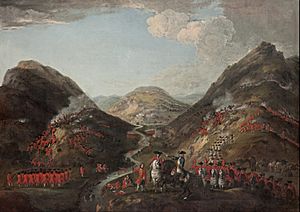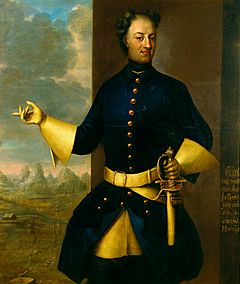Jacobite rising of 1719 facts for kids
Quick facts for kids Jacobite Rising of 1719 |
|||||||
|---|---|---|---|---|---|---|---|
| Part of the Jacobite risings and the War of the Quadruple Alliance | |||||||
 The Battle of Glenshiel 1719, Peter Tillemans |
|||||||
|
|||||||
| Belligerents | |||||||
Supported by: |
|||||||
| Commanders and leaders | |||||||
The Jacobite Rising of 1719 was a try to put James Francis Edward Stuart back on the throne of Great Britain. He was living in exile at the time. This event was part of several Jacobite uprisings between 1689 and 1745. It was the only one that Spain supported. Spain was at war with Britain during the War of the Quadruple Alliance.
The original plan was for 5,000 Spanish soldiers to land in South West England. A smaller group, led by Charles XII of Sweden, would land in Scotland. Scottish Jacobites were supposed to capture the port of Inverness. However, Charles died in November 1718, which ended Sweden's part in the plan. In late March, a small group of Spanish marines and Jacobite exiles landed in Stornoway. There, they found out that the main Spanish invasion fleet had been badly damaged by storms. The invasion of England was cancelled. The Rising ended with a defeat at the Battle of Glen Shiel in June.
Jacobite leaders felt this revolt actually hurt their cause. Over the next few years, important exiles like Bolingbroke and the Earl of Seaforth accepted pardons. They returned home. Others, like James and George Keith, stopped taking part in Jacobite plots. They found jobs with other countries. Many people, including James Stuart himself, felt this rising ended any real hope of him becoming king.
Contents
Why the Rising Happened
When the War of the Spanish Succession ended in 1713, Spain lost its lands in Italy, Sicily and Sardinia. Getting these lands back was very important to Giulio Alberoni, Spain's new chief minister. Sardinia was taken back in 1717. When Spanish troops landed on Sicily in July 1718, the Royal Navy destroyed the Spanish fleet. This battle, called the Battle of Cape Passaro, started the War of the Quadruple Alliance.
After King Louis XIV of France died in 1715, Britain and France signed a treaty in 1716. This treaty forced the Stuarts to leave France. It also helped George I become king of Britain smoothly. The 1715 Jacobite Rising had shown that the Stuarts still had many supporters. Alberoni wanted to use this to make Britain send its ships and soldiers away from the Mediterranean Sea.
He came up with a plan. About 5,000 Spanish soldiers, led by the exiled Duke of Ormonde, would land in South-West England. They would march to London and put James Stuart back on the throne.
Ormonde added another part to the plan. He had been involved in peace talks between Sweden and Russia. Charles XII of Sweden was having problems with Hanover over some lands in Germany. This showed the issues caused by George I being ruler of both Hanover and Britain. A small Scottish force would capture Inverness. This would allow a Swedish army to land there. However, Charles died in November 1718. This ended Sweden's involvement and the whole reason for the Scottish rising.

Preparations for the invasion were made in Cadiz, Spain. Ormonde and James waited in Coruña. A British Royal Navy group of ships watched the Spanish fleet outside Cadiz. As delays continued, Ormonde wrote worried letters to Alberoni. He said the plan was no longer possible. Historians wonder if Alberoni ever truly meant to go through with the invasion. It was part of a much bigger plan to change Europe. This included dividing the Ottoman empire and replacing the French Regent with Philip V of Spain.
The Battle of Cape Passaro showed how powerful the Royal Navy was. It was unlikely the Spanish fleet would even reach England. A threatened invasion could keep the Royal Navy busy without as much risk. This might explain why Alberoni didn't seem too worried about the delays. The Spanish fleet left Cadiz in late March. But a two-day storm near Cape Finisterre badly damaged it. The fleet went into Coruña on March 29 and stayed there.
The Scottish landing was led by George Keith. He left Pasajes, Spain, on March 8 with 300 Spanish marines on two ships. They landed at Stornoway on the Isle of Lewis. There, they met a group of exiles from France. These included the Earl of Seaforth, James Keith, the Marquess of Tullibardine, Lord George Murray, and Cameron of Lochiel. Britain later complained that France let these exiles pass freely. Some think France did this to reduce the money it had to pay to Jacobite exiles.
Tullibardine wanted to wait for news from Ormonde. But Keith wanted to capture Inverness quickly before the soldiers there were warned. Keith's idea won. On April 13, they landed at Lochalsh in Mackenzie land. They set up their base in Eilean Donan. Here, they learned that Ormonde's invasion had failed. Tullibardine, as commander of the Jacobite land forces, suggested they retreat. But Keith stopped this by sending the ships back to Spain.
With few choices left, the Jacobites prepared to march on Inverness. They had about 1,000 men. This included 400 Mackenzies, 150 Camerons, the Spanish soldiers, and other small groups. They had brought enough weapons and ammunition for 2,000 men. The extra supplies were stored at Eilean Donan, guarded by 40 Spanish marines. By mid-April, 2,500 Dutch soldiers had also arrived in Britain. The Dutch Republic sent these men to help the British Government. Only a few of them would fight.
The Rising Begins
Eilean Donan Castle Captured

After hearing about the landing in Stornoway, five Royal Navy ships arrived in the area in early May. They didn't know the Spanish ships had already left. This was a strong force. It included the large ships HMS Assistance, Worcester, Dartmouth, and Enterprise. There was also the smaller ship, Flamborough.
While Assistance and Dartmouth patrolled the waters around Skye, Worcester, Enterprise, and Flamborough anchored near Eilean Donan. This happened on the north side of Loch Duich early on Sunday, May 10. Seeing this, Tullibardine marched his men inland. Their options were limited. They couldn't escape by sea. Also, a government force led by Joseph Wightman was coming towards them from Inverness.
In the evening, a landing party captured the castle. They used heavy cannon fire to help them. The prisoners were taken by Flamborough to Edinburgh. Captain Boyle of Worcester wrote that they captured "an Irish captain, a Spanish lieutenant, a Spanish sergeant, thirty-nine Spanish soldiers and a Scots rebel." After blowing up the castle, the ships stayed in Loch Duich for two weeks. They searched for rebels and raided nearby Stromeferry and Raasay island.
The Battle of Glen Shiel

General Joseph Wightman left Inverness on June 5. He headed for Glen Shiel with about 1,000 men and four small cannons. They reached Loch Cluanie on June 9. This was less than 8 miles (13 km) from the Jacobite camp. Tullibardine blocked the mountain pass through the Five Sisters hills. He placed the Spanish soldiers in the middle. The Highlanders were on the sides, behind trenches and barricades.
Wightman's force arrived around 4:00 pm on June 10. They started their attack an hour later. They fired their small cannons at the Jacobite positions on the sides. This caused few injuries. But the Scots had never seen these cannons before. This allowed Wightman's soldiers to move up the hill to their lines. Then they used grenades to force the Jacobites out of their spots. The Spanish soldiers held their ground. But they had to move back up the mountain as their sides gave way.
The battle lasted until 9:00 pm. Some stories say the dry plants caught fire. Smoke and the fading light helped most of the Scots disappear into the night. The Spanish soldiers surrendered the next morning. As they were regular soldiers, they were sent home. Lord George Murray, Seaforth, and Tullibardine were wounded. But the Jacobite leaders also managed to escape. Wightman won the battle because he used his small cannons well. He also had more firepower and his soldiers were very aggressive.
Lord Carpenter, the commander in Scotland, told the government not to chase the rebels. He thought it was best to let them go. In a letter from June 16, 1719, to the Earl of Mar, Tullibardine described the battle. He said it "bid fair to ruin the King's Interest and faithful subjects in these parts."
What Happened Next

In October 1719, a British naval group captured the Spanish port of Vigo. They held it for ten days. They destroyed many supplies and equipment. Then they left without anyone stopping them, taking lots of stolen goods. This show of naval power led to Alberoni being fired. It also ended Spain's support for the Jacobites.
The government followed Lord Carpenter's advice. They mostly left the Highland fighters alone. But Seaforth's tenants kept paying their rent to him, even while he was in exile. The Mackenzies twice defeated attempts by the government to collect these rents. First at Glen Affric, then at Coille Bhan. This showed that the Highlands could not be controlled without the help of the clan chiefs. Only when Seaforth returned from exile in 1726 did the government regain control in the Mackenzie areas.
Many exiles accepted pardons. These included Bolingbroke and George Murray. Others found jobs in different countries. George and James Keith both became generals for Prussia. Ormonde lived quietly in Spain and Avignon until he died in November 1745. He was buried in Westminster Abbey in May 1746. Tullibardine stayed in exile. He took part in the 1745 Rising and died in the Tower of London in July 1746. Even though he swore loyalty to George II, Murray also joined the 1745 Rebellion. He died in the Dutch Republic in October 1760.
New laws made it harder for clergy who refused to swear loyalty to the new king. These were called Non-Juring clergy. In 1690, more than half of the clergy were Non-Jurors. They were supposed to lose their jobs. But many were protected by local important families. For example, Michael Fraser became a minister in Daviot and Dunlichty in 1673. Even though he was removed in 1694 and joined the 1715 and 1719 Risings, he was still there when he died in 1726.
Before 1719, attempts to bring ministers like Michael Fraser back into the official church were stopped by the church's General Assembly. After 1719, the government started to persecute these Non-Juring clergy. Many changed their minds and joined the official church. Being a Non-Juring Episcopalian became a sign of supporting the Jacobites. It was often linked to powerful local leaders. This was because their church groups needed political protection to survive. A large number of people from both the Lowlands and Highlands who took part in the 1745 Rebellion came from this part of Scottish society.
See also
 In Spanish: Rebelión jacobita de 1719 para niños
In Spanish: Rebelión jacobita de 1719 para niños


